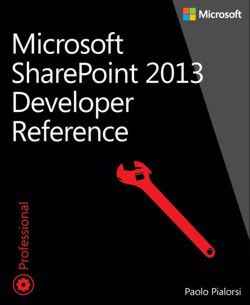| Microsoft SharePoint 2013 Developer Reference |
|
Author: Paolo Pialorsi SharePoint has lots of options for developers, both internal tools and addressed from other programming environments via its classes, libraries and controls. Whether you like it or loathe it, SharePoint is an environment many companies rely on, and this looks set to increase with the rise of Office 365 and its ties with SharePoint. The nature of SharePoint means it has lots of options for developers, both internal tools and addressed from other programming environments via its classes, libraries and controls. SharePoint 2013 Developer Reference takes you from a quick overview of SharePoint 2013 and its data foundations through developing SharePoint apps, extending SharePoint and developing workflows.
This is a hefty book with a lot of code. The initial section takes you on a quick tour of SharePoint, the basic concepts, which editions are available, and the main options open for developers. There’s also a comprehensive chapter listing the ways SharePoint stores its data. Part II is where most developers will begin to find the book useful. It discusses developing SharePoint solution using the core libraries on the server side using the SharePoint Server Object Model and the new LINQ to SharePoint provider. It also looks at how to develop for the client side using the SharePoint Client Object Model and SOAP services.
By Part III Pialorsi has moved on to developing SharePoint apps. There’s a guide to creating different kinds of apps, and a good chapter on the new REST (Representational State Transfer) APIs that have been introduced with SharePoint 2013 for making use of SharePoint resources from external apps. Another useful chapter shows how to develop remote event receivers to create apps that can react to SharePoint events. While SharePoint has an extensive environment, you can extend it with Web Parts and custom pages and web templates, and that’s what’s covered in Part IV of the book. Then Part V gives a brief intro to Windows Workflow Foundation (WF), and the new workflow architecture in SharePoint 2013. There are also chapters on designing workflows with SharePoint Designer 2013 and with Visual Studio 2012. The section ends with a chapter on advanced workflows covering creating custom actions and using the Workflow Services Manager. The final section looks at security, with coverage of authentication, authorization, and how to use claims-based security and identity federation. The style of the book is similar to a manual, with tables showing names and descriptions of aspects of SharePoint such as properties, attributes, event types, and functions. There’s a lot of code, and plenty of screenshots. One difficulty with the printed edition of the book is that the screenshots can be tricky to read because they’ve been captured in color and printed in very faint shades of grey. This is a solid book in terms of the material covered; it’s written in a workmanlike style, and covers the ground thoroughly. Pialorsi isn’t a particularly chatty writer, but he can be forgiven that given the amount of material he had to get through. If you need to learn SharePoint development, it’s a good title.
|
|||
| Last Updated ( Monday, 23 September 2013 ) |

